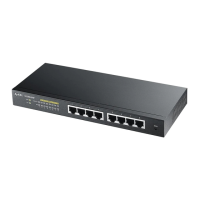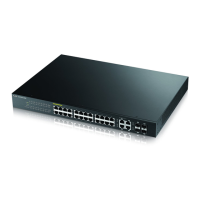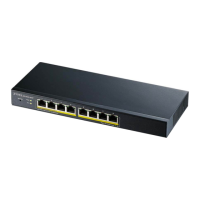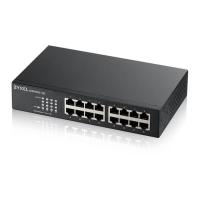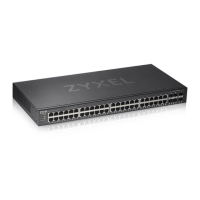
Do you have a question about the ZyXEL Communications GS1350 Series and is the answer not in the manual?
| Brand | ZyXEL Communications |
|---|---|
| Model | GS1350 Series |
| Category | Switch |
| Language | English |
Explains the Switch as a Power Sourcing Equipment (PSE) and PoE standards.
Lists methods for managing the Switch, including Web Configurator, CLI, and SNMP.
Provides recommendations for secure and effective Switch management, including password changes and backups.
Lists precautions before using the Switch, including clearance and ventilation.
Details the steps for installing the Switch on a desktop.
Details the importance and procedure for grounding the Switch for safety and ESD protection.
Explains how to connect power to the Switch, noting airflow requirements.
Details the steps to log into the Switch using the Web Configurator via browser.
Explains how to set up IP/DNS, password, SNMP community, and link aggregation.
Details how to configure loop guard and broadcast storm control for ports.
Guides on creating VLANs and configuring VLAN tag settings.
Recommends changing the default administrator password after the first login.
Explains how to save changes to run-time and non-volatile memory.
Explains how to reload factory default configuration or reset the Switch.
Guides on creating a VLAN and configuring port membership.
Explains using PVID to tag incoming untagged frames for VLAN forwarding.
Describes how to configure the management IP address in a different subnet.
Provides a tutorial on configuring DHCPv4 snooping to assign IPs and manage VLANs.
Explains configuring the Switch to forward DHCP client requests to a specific DHCP server.
Manages IP addresses, routing domains, and VLAN association for network access.
Allows creation and editing of IP routing domains and management IP addresses.
Configures port settings such as speed, duplex, flow control, and 802.1p priority.
Displays power supplied to PDs, PoE usage, and port status.
Configures PoE power management mode, priority, power-up, and maximum power.
Guides on configuring static VLANs by defining port membership and tagging.
Configures static VLAN (IEEE 802.1Q) settings on a port, including PVID and frame types.
Explains setting static MAC addresses for ports to reduce broadcasting needs.
Explains creating rules to filter traffic based on MAC addresses and VLANs.
Displays RSTP status, including bridge information and port states.
Guides on configuring RSTP settings for network loop prevention.
Explains how to set ingress and egress rate limits for traffic control on ports.
Details setting limits for broadcast, multicast, and DLF packets per second on ports.
Explains selecting a monitor port and specifying traffic flow for copying.
Displays configured trunk groups, synchronized ports, and aggregator ID.
Enables static link aggregation by configuring group ID, active status, and traffic distribution criteria.
Enables LACP for dynamic link aggregation and port redundancy.
Details enabling port security and disabling MAC address learning.
Explains creating absolute or periodic schedules for time-oriented features.
Details setting priorities for traffic queues using SPQ, WFQ, or WRR methods.
Explains IGMP snooping configuration for forwarding multicast traffic efficiently.
Guides on enabling IGMP snooping on specific VLANs and configuring option 82 profiles.
Guides on configuring RADIUS server settings for authentication and authorization.
Configures authentication, authorization, and accounting methods and priorities.
Enables DHCP snooping, specifies VLANs, and configures the DHCP snooping database.
Specifies trusted/untrusted ports for DHCP snooping and sets packet rate limits.
Enables DHCP snooping on VLANs and configures option 82 information.
Applies different DHCP option 82 profiles to specific ports within a VLAN.
Details enabling loop guard on the Switch and specific ports, noting compatibility with RSTP.
Limits control packets (ARP, BPDU, IGMP) receivable or transmittable per port.
Detects control packet rate limits and configures actions upon exceeding them.
Configures automatic undoing of actions after errors are resolved, including timers.
Enables automatic PD recovery and configures LLDP or ping checks.
Details activating automatic PD recovery by selecting ports, mode, and actions.
Activates DiffServ to apply marking rules or IEEE 802.1p priority mapping.
Explains adding Relay Agent Information to DHCP requests for source authentication.
Guides on creating DHCPv4 option 82 profiles for Circuit ID and Remote ID sub-options.
Configures global DHCPv4 relay to forward requests to a DHCP server.
Applies DHCP option 82 profiles to specific ports for global relay.
Configures DHCP settings based on VLAN domain, specifying DHCP server per VLAN.
Applies different DHCP option 82 profiles to specific ports within a VLAN.
Resets the Switch configuration to Zyxel default settings.
Saves current configuration settings permanently to Configuration 1, 2, or Custom Default.
Restarts the Switch and loads a selected configuration file (Current, Custom, or Factory Default).
Guides on upgrading the Switch to the latest firmware, emphasizing correct model selection.
Restores a previously saved device configuration from a computer.
Creates "snap shots" of device configurations for later restoration.
Configures SNMP settings, including version and community values.
Specifies types of SNMP traps to send to SNMP managers.
Sets whether SNMP traps received on ports are sent to the SNMP manager.
Creates SNMP users for authentication with managers using SNMP v3.
Configures up to five login accounts (one administrator, four users) for Web Configurator access.
Specifies trusted computers for managing the Switch via various services.
Provides tools for pinging, tracerouting, port testing, and location checks.
Displays current system logs, including time and reason for messages.
Displays the Switch's role (Manager, Member, None) within the cluster.
Configures clustering management, including setting up the cluster manager.
Allows checking if MAC addresses are dynamic or static and viewing the MAC table.
Allows viewing IP-to-MAC address mappings and removing dynamic ARP entries.
Allows copying basic and advanced settings from a source port to destination ports.
Displays port statistical summary and links to detailed statistics.
Views and manages neighboring devices, including login, reboot, and factory reset.
Enables automatic PD recovery and configures LLDP or ping checks.
Displays power supplied to PDs, PoE usage, and port status.
Configures PoE power management mode, priority, power-up, and maximum power.
Configures port settings such as speed, duplex, flow control, and 802.1p priority.
Limits broadcast, multicast, and DLF packets per second on ports.
Logically aggregates physical links for higher bandwidth.
Displays configured trunk groups, synchronized ports, and aggregator ID.
Enables static link aggregation by configuring group ID, active status, and traffic distribution criteria.
Enables LACP for dynamic link aggregation and port redundancy.
Configures the Switch to guard against loops on the edge of the network.
Covers configuration of 802.1Q tagged and port-based VLANs.
Guides on deciding how incoming frames should be handled based on VLAN tags.
Configures static VLAN (IEEE 802.1Q) settings on a port, including PVID and frame types.
Configures default gateway, domain name server, and IP domains.
Configures up to five login accounts (one administrator, four users) for Web Configurator access.
Specifies trusted computers for managing the Switch via various services.
Configures SNMP settings, including version and community values.
Specifies types of SNMP traps to send to SNMP managers.
Sets whether SNMP traps received on ports are sent to the SNMP manager.
Creates SNMP users for authentication with managers using SNMP v3.
Decides which services are allowed for access and configures default service ports.
Saves device configurations and log files for later restoration.
Guides on upgrading the Switch to the latest firmware, emphasizing correct model selection.
Restarts the Switch and loads a selected configuration file (Current, Custom, or Factory Default).
Restores a previously saved device configuration from a computer.
Saves current configuration settings to a specific file or the current configuration.
Addresses issues with the Switch not turning on and unexpected LED behavior.
Troubleshoots issues related to forgetting IP addresses, usernames, or passwords.
Describes automatic IPv6 address generation without a DHCP server.
Describes DHCP relay agents for forwarding messages between clients and servers.
Provides crucial safety warnings for product usage, installation, and handling.
